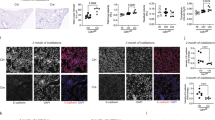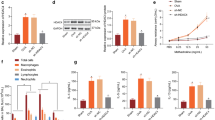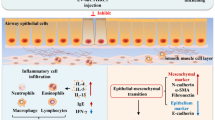Abstract
Brahma-related gene-1 (Brg1), a key chromatin remodeling factor, is associated with cell proliferation and migration in kidney and heart cells, but few reports have examined its role in airway epithelial cell. Airway epithelial injury, which is involved in the entire pathological process of asthma, is an important cause of recurrent asthma. Here, we studied the function of Brg1 in an ovalbumin (OVA)-induced asthma model (lung-specific conditional Brg1 (Brg1−/−) knockdown mice) and human bronchial epithelial 16HBE cells stably expressing Brg1 shRNA. Our results showed that high expression of Brg1 was detected in asthmatic children and in mouse models. Brg1−/− mice showed improved airway hyperresponsiveness (AHR) and bronchial epithelial integrity, along with reduced inflammatory cell infiltration and airway mucus secretion, when challenged with OVA. Furthermore, cell proliferation, migration, and expression of E-cadherin increased in 16HBE cells in which Brg1 was silenced. We further demonstrated that Brg1 bound to and inactivated a critical region (−86/+60 bp) within the E-cadherin promoter in bronchial epithelial cells. Thus, Brg1 might act as an important regulator of airway epithelial integrity in asthma progression and might be a novel therapeutic target.
Key messages
• Depletion of Brg1 improves the integrity of airway epithelium in asthma by regulating E-cadherin expression in lung epithelial cells.
• Knockdown of Brg1 increased the cell proliferation and migration by human bronchial epithelial 16HBE cells.
• Brg1 might bLLe a novel therapeutic target in asthma.





Similar content being viewed by others
References
Braman SS (2006) The global burden of asthma. Chest 130(1 Suppl):4S–12S
Giovannini-Chami L, Albertini M, Scheinmann P, de Blic J (2015) New insights into the treatment of severe asthma in children. Paediatr Respir Rev 16:167–173
Matsubara S, Fushimi K, Kaminuma O, Kikkawa H, Shimazu N, Iwasaki H, Ikezawa K (1995) Importance of impairment of the airway epithelium for ozone-induced airway hyperresponsiveness in guinea pigs. Jpn J Pharmacol 67:375–382
Li JJ, Wang W, Baines KJ, Bowden NA, Hansbro PM, Gibson PG, Kumar RK, Foster PS, Yang M (2010) IL-27/IFN-gamma induce MyD88-dependent steroid-resistant airway hyperresponsiveness by inhibiting glucocorticoid signaling in macrophages. J Immunol 185(7):4401–4409
Haj-Salem I, Fakhfakh R, Bérubé JC, Jacques E, Plante S, Simard MJ, Bossé Y, Chakir J (2015) MicroRNA-19a enhances proliferation of bronchial epithelial cells by targeting TGFβR2 gene in severe asthma. Allergy 70:212–219
Hackett TL, Warner SM, Stefanowicz D, Shaheen F, Pechkovsky DV, Murray LA, Argentieri R, Kicic A, Stick SM, Bai TR, Knight DA (2009) Induction of epithelial-mesenchymal transition in primary airway epithelial cells from patients with asthma by transforming growth factor-beta1. Am J Respir Crit Care Med 180:122–133
Vandewalle C, Comijn J, De Craene B, Vermassen P, Bruyneel E, Andersen H, Tulchinsky E, Van Roy F, Berx G (2005) SIP1/ZEB2 induces EMT by repressing genes of different epithelial cell-cell junctions. Nucleic Acids Res 33:6566–6578
Sussan TE, Gajghate S, Chatterjee S, Mandke P, McCormick S, Sudini K, Kumar S, Breysse PN, Diette GB, Sidhaye VK et al (2015) Nrf2 reduces allergic asthma in mice through enhanced airway epithelial cytoprotective function. Am J Physiol Lung Cell Mol Physiol 309:L27–L36
Hardyman MA, Wilkinson E, Martin E, Jayasekera NP, Blume C, Swindle EJ, Gozzard N, Holgate ST, Howarth PH, Davies DE et al (2013) TNF-α-mediated bronchial barrier disruption and regulation by src-family kinase activation. J Allergy Clin Immunol 132:665–675.e8
Liu J, Zhang M, Niu C, Luo Z, Dai J, Wang L, Liu E, Fu Z (2013) Dexamethasone inhibits repair of human airway epithelial cells mediated by glucocorticoid-induced leucine zipper (GILZ). PLoS One 8:e60705
Niu C, Liu N, Liu J, Zhang M, Ying L, Wang L, Tian D, Dai J, Luo Z, Liu E et al (2016) Vitamin A maintains the airway epithelium in a murine model of asthma by suppressing glucocorticoid-induced leucine zipper. Clin Exp Allergy 46:848–860
Hohmann AF, Vakoc CR (2014) A rationale to target the SWI/SNF complex for cancer therapy. Trends Genet 30:356–363
Banine F, Bartlett C, Gunawardena R, Muchardt C, Yaniv M, Knudsen ES, Weissman BE, Sherman LS (2005) SWI/SNF chromatin-remodeling factors induce changes in DNA methylation to promote transcriptional activation. Cancer Res 65:3542–3547
Qi W, Wang R, Chen H, Wang X, Xiao T, Boldogh I, Ba X, Han L, Zeng X (2015) BRG1 promotes the repair of DNA double-strand breaks by facilitating the replacement of RPA with RAD51. J Cell Sci 128:317–330
Weiss RM, Guo S, Shan A, Shi H, Romano RA, Sinha S, Cantley LG, Guo JK (2013) Brg1 determines urothelial cell fate during ureter development. J Am Soc Nephrol 24:618–626
Xiong Y, Li W, Shang C, Chen RM, Han P, Yang J, Stankunas K, Wu B, Pan M, Zhou B et al (2013) Brg1 governs a positive feedback circuit in the hair follicle for tissue regeneration and repair. Dev Cell 25:169–181
Holik AZ, Krzystyniak J, Young M, Richardson K, Jardé T, Chambon P, Shorning BY, Clarke AR (2013) Brg1 is required for stem cell maintenance in the murine intestinal epithelium in a tissue-specific manner. Stem Cells 31:2457–2466
Bevilacqua A, Willis MS, Bultman SJ (2014) SWI/SNF chromatin-remodeling complexes in cardiovascular development and disease. Cardiovasc Pathol 23:85–91
Glaros S, Cirrincione GM, Palanca A, Metzger D, Reisman D (2008) Targeted knockout of BRG1 potentiates lung cancer development. Cancer Res 68:3689–3696
Kawanami O, Tanaka M, Mitsui T, Kawai T (1989) Bronchiolo-fiberscopic, histological and ultrastructural studies of peripheral lung tissues in bronchial asthma patients. Nihon Kyobu Shikkan Gakkai Zasshi 27:925–932
Krause DS (2008) Bone marrow-derived lung epithelial cells. Proc Am Thorac Soc 5:699–702
Hong KU, Reynolds SD, Giangreco A, Hurley CM, Stripp BR (2001) Clara cell secretory protein-expressing cells of the airway neuroepithelial body microenvironment include a label-retaining subset and are critical for epithelial renewal after progenitor cell depletion. Am J Respir Cell Mol Biol 24:671–681
Reynolds SD, Hong KU, Giangreco A, Mango GW, Guron C, Morimoto Y, Stripp BR (2000) Conditional clara cell ablation reveals a self-renewing progenitor function of pulmonary neuroendocrine cells. Am J Physiol Lung Cell Mol Physiol 278:L1256–L1263
Engelhardt JF (2001) Stem cell niches in the mouse airway. Am J Respir Cell Mol Biol 24:649–652
Fehrenbach H (2001) Alveolar epithelial type II cell: defender of the alveolus revisited. Respir Res 2:33–46
Desai LP, Sinclair SE, Chapman KE, Hassid A, Waters CM (2007) High tidal volume mechanical ventilation with hyperoxia alters alveolar type II cell adhesion. Am J Physiol Lung Cell Mol Physiol 293:L769–L778
Desai LP, Aryal AM, Ceacareanu B, Hassid A, Waters CM (2004) RhoA and Rac1 are both required for efficient wound closure of airway epithelial cells. Am J Physiol Lung Cell Mol Physiol 287:L1134–L1144
Ren ZX, Yu HB, Li JS, Shen JL, Du WS (2015) Suitable parameter choice on quantitative morphology of A549 cell in epithelial-mesenchymal transition. Biosci Rep 35:e00202
Cohet N, Stewart KM, Mudhasani R, Asirvatham AJ, Mallappa C, Imbalzano KM, Weaver VM, Imbalzano AN, Nickerson JA (2010) SWI/SNF chromatin remodeling enzyme ATPases promote cell proliferation in normal mammary epithelial cells. J Cell Physiol 223:667–678
Wu Q, Madany P, Akech J, Dobson JR, Douthwright S, Browne G, Colby JL, Winter GE, Bradner JE, Pratap J et al (2015) The SWI/SNF ATPases are required for triple negative breast cancer cell proliferation. J Cell Physiol 230:2683–2694
Sánchez-Tilló E, Lázaro A, Torrent R, Cuatrecasas M, Vaquero EC, Castells A, Engel P, Postigo A (2010) ZEB1 represses E-cadherin and induces an EMT by recruiting the SWI/SNF chromatin-remodeling protein BRG1. Oncogene 29:3490–3500
Wang L, Baiocchi RA, Pal S, Mosialos G, Caligiuri M, Sif S (2005) The BRG1- and hBRM-associated factor BAF57 induces apoptosis by stimulating expression of the cylindromatosis tumor suppressor gene. Mol Cell Biol 25:7953–7965
Hendricks KB, Shanahan F, Lees E (2004) Role for BRG1 in cell cycle control and tumor suppression. Mol Cell Biol 24:362–376
Liu R, Liu H, Chen X, Kirby M, Brown PO, Zhao K (2001) Regulation of CSF1 promoter by the SWI/SNF-like BAF complex. Cell 106:309–318
Marquez-Vilendrer SB, Thompson K, Lu L, Reisman D (2016) Mechanism of BRG1 silencing in primary cancers. Oncotarget 7:56153–56169
Matsubara D, Kishaba Y, Ishikawa S, Sakatani T, Oguni S, Tamura T, Hoshino H, Sugiyama Y, Endo S, Murakami Y et al (2013) Lung cancer with loss of BRG1/BRM, shows epithelial mesenchymal transition phenotype and distinct histologic and genetic features. Cancer Sci 104:266–273
Fang F, Chen D, Yu L, Dai X, Yang Y, Tian W, Cheng X, Xu H, Weng X, Fang M et al (2013) Proinflammatory stimuli engage Brahma related gene 1 and Brahma in endothelial injury. Circ Res 113:986–996
Zager RA, Johnson AC (2009) Renal ischemia-reperfusion injury upregulates histone-modifying enzyme systems and alters histone expression at proinflammatory/profibrotic genes. Am J Physiol Renal Physiol 296:F1032–F1041
McKeever T, Harrison TW, Hubbard R, Shaw D (2013) Inhaled corticosteroids and the risk of pneumonia in people with asthma: a case-control study. Chest 144:1788–1794
Chen T, Wang C, Wu F, Zhang X, Yang H, Deng X, He Q, Li W, Li G (2015) Altered localization of p120 catenin in the cytoplasm rather than the membrane correlates with poor prognosis in esophageal squamous cell carcinoma. PLoS One 10:e0118645
Acknowledgements
This work was partially supported by grants from the National Natural Science Foundation of China (81670018, 81600022, 81070014), the Chongqing Municipal Health Bureau (2010-1-46), and the Chongqing Science and Technology Commission (cxtc2014yykfc10003).
Author information
Authors and Affiliations
Corresponding authors
Ethics declarations
Conflict of interest
The authors have no conflicts of interest to declare.
Electronic supplementary material
ESM 1
(PDF 529 kb)
Rights and permissions
About this article
Cite this article
Wang, T., Zou, W., Niu, C. et al. Brg1 inhibits E-cadherin expression in lung epithelial cells and disrupts epithelial integrity. J Mol Med 95, 1117–1126 (2017). https://doi.org/10.1007/s00109-017-1576-7
Received:
Revised:
Accepted:
Published:
Issue Date:
DOI: https://doi.org/10.1007/s00109-017-1576-7




